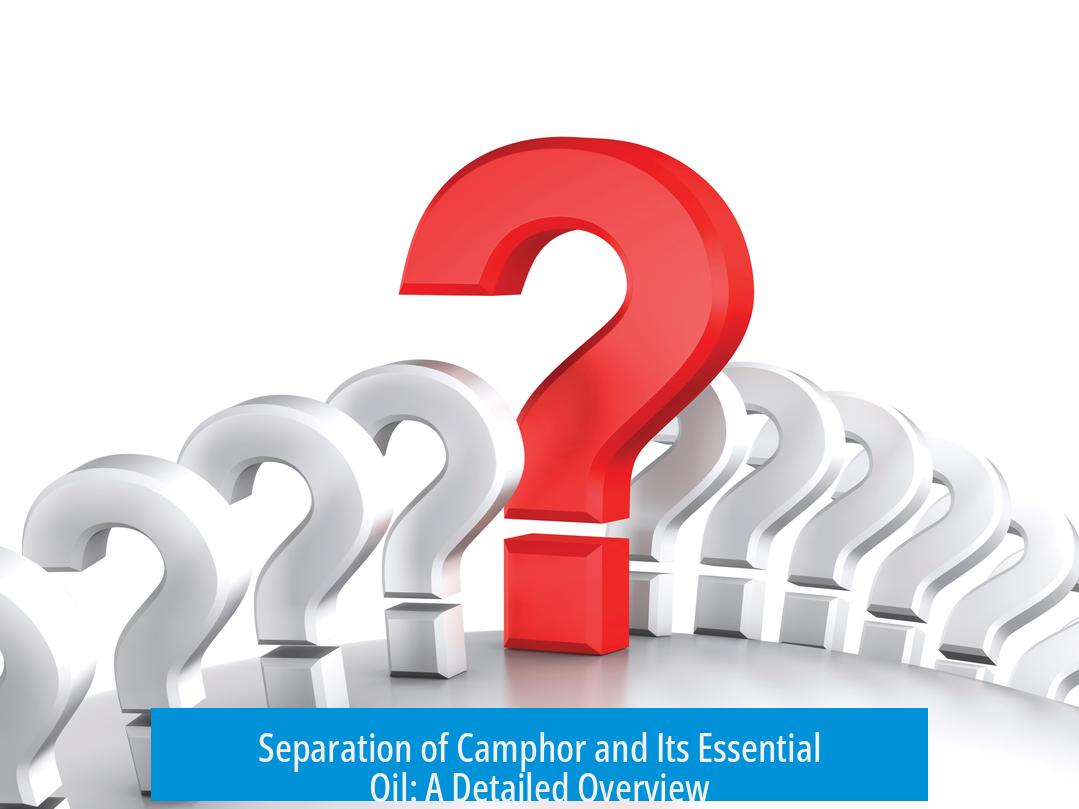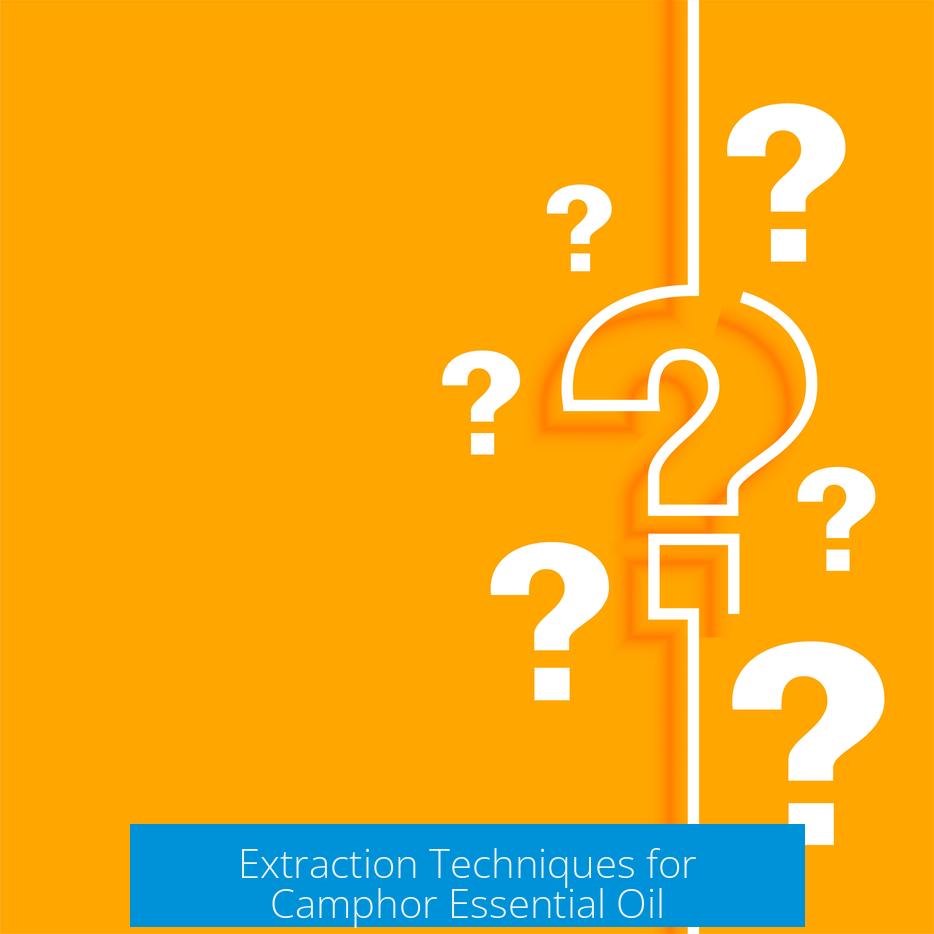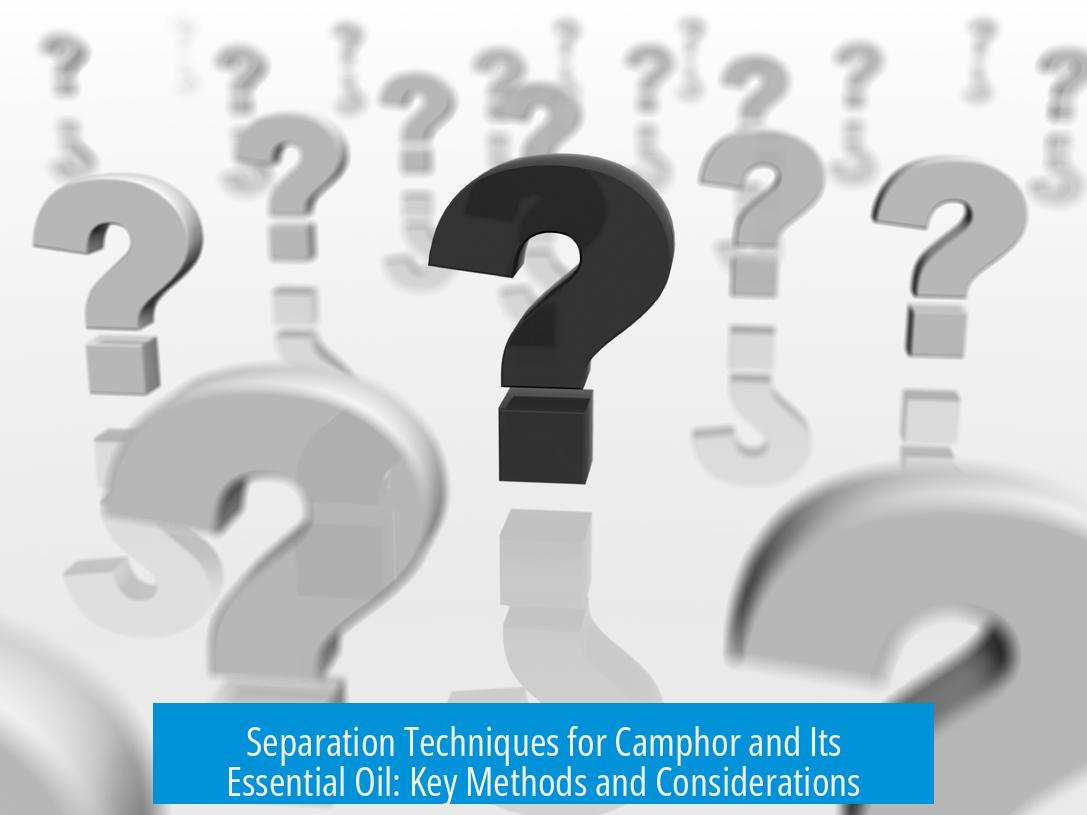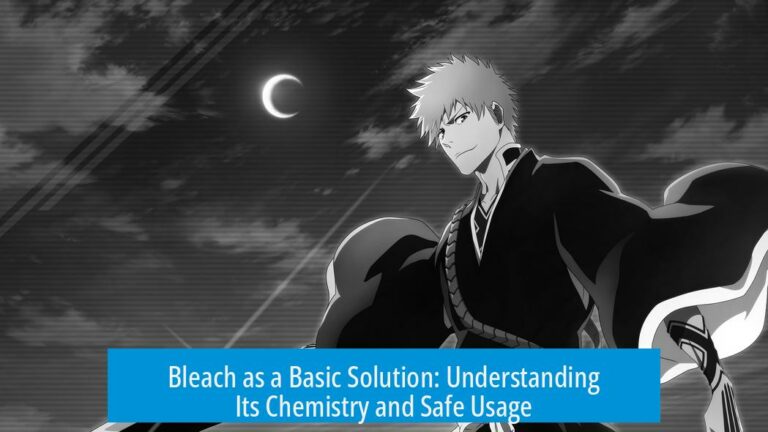Separation of Camphor and Its Essential Oil: A Detailed Overview

The separation of camphor from camphor essential oil involves exploiting their distinct physical and chemical properties, mainly through advanced extraction methods such as steam distillation and supercritical CO2 extraction. Camphor, a solid white compound with high vapor pressure, differs fundamentally from the volatile and complex mixture that constitutes camphor essential oil.
Understanding Camphor and Essential Oil Characteristics
Camphor is a crystalline solid, not an oil, characterized by its relatively high vapor pressure which allows it to sublime easily. By contrast, camphor essential oil is a complex mixture of volatile organic compounds extracted primarily from camphor tree leaves. These compounds include terpenes, alcohols, esters, and other phytochemicals. Effective separation relies on their differing physical states and volatilities.
Extraction Techniques for Camphor Essential Oil

Multiple methods exist to extract essential oil from camphor trees. Techniques vary in yield, chemical composition of the extracts, and suitability for preserving oil quality:
- Steam Distillation: A conventional technique that produces essential oil yields below 0.5% from fresh plant material. This method efficiently extracts low boiling point volatiles including esters and epoxides.
- Supercritical Carbon Dioxide Extraction (SC-CO2): A modern method yielding up to 4.63% essential oil under optimized conditions of 25 MPa pressure, 45 °C temperature, and 2.5 hours extraction time. This technique selectively extracts weakly polar substances and higher alcohol content while minimizing oxidation and loss of heat-sensitive compounds.
- Other Methods: Organic solvent extraction, microwave-assisted extraction, ultrasound-assisted extraction, ionic liquid combined extraction, cold-pressed extraction, and solvent-free microwave extraction exist but are less commonly employed or optimized for camphor.
Separation of Camphor from Essential Oil
Camphor content in essential oil varies depending on the extraction method:
| Method | Camphor Content (Area %) |
|---|---|
| Steam Distillation | 3.39% |
| Supercritical CO2 Extraction | 9.05% |
Due to camphor’s physical state as a solid and selective solubility properties, it is more efficiently extracted and isolated using supercritical CO2 extraction. Camphor dissolves readily in supercritical CO2 at phase equilibrium, enabling enhanced extraction rates and selectivity.
Key Process Parameters Influencing Supercritical CO2 Extraction

- Temperature: Optimal temperature for extraction is around 45 °C. Extraction yields peak at this temperature (~5%), then slightly decrease and stabilize beyond 50 °C.
- Pressure: Extraction rates increase with pressure up to 20 MPa. Beyond 20 MPa, extraction rates drop and selectivity worsens due to higher CO2 density extracting more complex oxidized compounds.
- Time: Rate of extraction rises rapidly in the first 2 hours and slows thereafter. Extending beyond 3 hours yields minimal improvement.
Advantages of Supercritical CO2 Extraction for Camphor and Essential Oil
- Selective Extraction: It targets weak polar and heat-sensitive compounds, preserving essential oil integrity and camphor purity.
- Non-toxic and Inert: CO2 is safe, non-flammable, and does not leave harmful residues.
- Adjustable Parameters: Fine-tuning of pressure and temperature enhances yield and selectivity according to the desired component.
- Prevention of Oxidation: Conditions prevent chemical degradation of components.
Comparison Between Steam Distillation and Supercritical CO2 Methods

| Aspect | Steam Distillation | Supercritical CO2 Extraction |
|---|---|---|
| Yield | < 0.5% | ~4.63% |
| Camphor Content | 3.39% | 9.05% |
| Selective Extraction | Low boiling point volatiles, esters, epoxides | Weak polar compounds, alcohols, camphor |
| Preservation of Heat-sensitive Compounds | Poor | Good |
| Environmental Impact | Requires steam, energy | Uses non-toxic CO2 |
Additional Considerations on Camphor Isolation
Camphor can also be chemically separated by converting it to camphoroxime through reaction with hydroxylamine hydrochloride. Optimization of solvent type, temperature, and reactant concentration enhances the efficiency of camphor recovery from camphor oil extracts. However, this process follows the initial physical extraction step.
Key Takeaways
- Camphor is a solid, separable from camphor essential oil, which is a volatile liquid mixture.
- Supercritical CO2 extraction is the preferred method for separation due to higher yield, selectivity, and preservation of compounds.
- Steam distillation yields less oil and lower camphor content with more heat-sensitive degradation.
- Extraction parameters—temperature (around 45 °C), pressure (~20 MPa), and time (~2.5 h)—critically impact yield and purity.
- After physical extraction, chemical methods like camphoroxime formation can purify camphor further.
Question about Separation of Camphor and Its Essential Oil: A Deep Dive into Extraction Techniques
How do we effectively separate camphor, a solid substance, from its essential oil? The simple answer is: by choosing the right extraction method, primarily comparing steam distillation with supercritical CO2 extraction, each offering distinct yield, selectivity, and preservation qualities.
Let’s unravel this question in detail, putting on our lab coats — metaphorically, of course — and exploring both the science and some practical insights around camphor and its essential oil extraction.
Understanding Camphor and Its Nature
First things first: camphor is NOT an oil. Contrary to what you might imagine, camphor is a solid, white, crystalline substance. Its relatively high vapor pressure means it readily volatilizes, which makes certain extraction methods ideal and others less so. Trying to treat camphor like a liquid oil is like trying to balance a broomstick on your finger – it just behaves differently.
The Essential Oil of Camphor Tree: What’s Inside?
The camphor tree’s essential oil isn’t just camphor. It contains a variety of components, such as neroli tertiary alcohol and caryophyllene oxide. Interestingly, camphor content isn’t always the dominant ingredient in these essential oils; it varies depending on the extraction technique applied.
Extraction Methods and Their Impact on Camphor Separation
There are multiple extraction methods for obtaining camphor tree essential oil, including steam distillation, organic solvent extraction, microwave-assisted extraction, and of course, the heating superstar – supercritical CO2 extraction. Each method influences both how much oil you get and which chemicals, including camphor, you isolate.
The choice of method is crucial because you want to maximize yield while preserving delicate components. Depending on the method, some components might degrade or evaporate, and the amount of camphor extracted can vary significantly.
Steam Distillation: The Old Faithful
Steam distillation involves passing steam through the plant material to vaporize volatile compounds. It’s a tried and true method but not without its shortcomings. Typically, steam distillation achieves an extraction rate of less than 0.5%, quite low for commercial scaling.
Steam distillation excels at extracting volatile, low-boiling-point substances, including various esters and epoxides. However, it falters when it comes to extracting heat-sensitive components and preserving high camphor content. Why? Because camphor can partially degrade or escape during the lengthy heating involved.
One study reported camphor comprising just around 3.39% of the essential oil obtained through steam distillation, reflecting its limitations in separating and concentrating camphor.
Supercritical CO2 Extraction: The High-Tech Contender
Enter the supercritical CO2 extraction method, which uses carbon dioxide above its critical temperature and pressure (making it neither a gas nor a liquid, but a supercritical fluid). This method is gaining popularity soon as the extraction technique of the future.
Why? Because supercritical CO2 boasts high diffusivity, solubility, and selectivity. It can selectively isolate essential oil components, including camphor, without causing oxidation or losing heat-sensitive substances.
Its advantages are impressive:
- Non-toxic, relatively inert, and non-flammable, making it safe and environmentally friendly.
- The extraction results can be fine-tuned by adjusting pressure and temperature.
- Higher yield—up to 4.63% under optimal conditions (25 MPa, 45 °C, 2.5 hours), roughly ten times the yield of steam distillation.
More importantly, the camphor content in supercritical CO2 extracted oil was about 9.05%, significantly higher than that from steam distillation. The higher camphor concentration reflects the method’s superior selectivity.
Optimizing Process Parameters in Supercritical CO2 Extraction
Here’s where the method gets technical and fascinating and why not all supercritical extractions are created equal:
| Parameter | Effect on Yield | Notes |
|---|---|---|
| Temperature | Highest yield at 45 °C (~5%) | Above 45 °C, yield stabilizes or drops slightly due to thermal effects |
| Pressure | Optimal at 20-25 MPa; higher pressure reduces yield | Too high pressure causes complex extracts, reduced selectivity |
| Time | Yield increases rapidly up to 2 h; plateaus after 3 h | Prolonged extraction offers diminishing returns |
These parameters matter greatly. Adjusting pressure affects CO2 density and therefore its solvency power. Think of pressure as how tightly CO2 hugs the camphor and oil molecules—too loose, and you miss some; too tight, and you grab too many unwanted compounds.
Separating Camphor from Essential Oil: More Than Just Extraction
Separation doesn’t end at extraction. For industrial purposes, camphor must be isolated from the complex essential oil mixture.
One known approach involves chemical modification — the production of camphoroxime through camphor’s reaction with hydroxylamine. Studies show that optimizing this reaction requires balancing hydroxylamine hydrochloride amount, solvent type (ethanol), and reaction temperature.
This approach focuses on camphor specifically, allowing for enhanced isolation ultimately used for pharmaceutical and industrial applications.
Why Does This Technical Debate Matter?
You might wonder, “Who cares if camphor is separated this way or that?” Well, camphor finds itself surfacing in:
- Medicinal products — due to its antimicrobial and anti-inflammatory properties.
- Aromatherapy — where oil composition affects aroma and therapeutic effect.
- Industrial uses — as a plasticizer and in explosives.
Choosing a superior extraction and separation method improves quality, yield, and sustainability. You save money, preserve the oil’s integrity, and satisfy regulations limiting solvents or harmful practices.
Practical Tips & Recommendations for Researchers or Producers
- Favor supercritical CO2 extraction when your goal is maximal yield and rich camphor content. It respects the compounds’ thermosensitivity well.
- Tune extraction parameters carefully: 20-25 MPa pressure and around 45 °C optimize yield and selectivity.
- Keep extraction time around 2.5 hours for a productive balance—waiting longer might not help.
- Use chemical derivatization (e.g., camphoroxime formation) to isolate camphor from essential oil when purity matters.
- Steam distillation remains useful if you need a simple method focused on more volatile fractions, though expect lower camphor content.
A Fresh Angle: Environmental and Safety Considerations
Supercritical CO2 extraction also shines by being greener. It doesn’t rely on organic solvents with hazardous disposal issues. Plus, its non-flammability means safer operations.
In contrast, steam distillation demands significant heat inputs, and solvent extraction risks pollution.
Isn’t it intriguing how modern science marries efficiency with sustainability?
Wrap-Up: The Best Way to Separate Camphor and Its Essential Oil?
In summary, supercritical CO2 extraction stands out as the superior technique both for extracting essential oils rich in camphor and selectively separating camphor from other components. Its tunable parameters allow precision control, and it prevents the loss of sensitive substances, resulting in a higher yield and quality extract.
Steam distillation, while traditional, falls short in yield and camphor concentration, making it less ideal if camphor is your target.
So, when you’re pondering that fundamental question — how to separate camphor and its essential oil — think beyond the chalkboard and lean into the nuances of technique. Each method has its place, but supercritical CO2 extraction is clearly a game-changer in the field.
Still curious about camphor? Have you tried or heard of other innovative extraction techniques? Or perhaps home-brewed essential oils? Share your experiences or questions below — extraction can be quite the bubbling cauldron of chemistry and craftsmanship, after all!
1. What makes camphor different from its essential oil in terms of physical state?
Camphor is a solid white substance with high vapor pressure. It is not an oil, unlike its essential oil which is liquid and contains volatile compounds extracted from the camphor tree.
2. Why are different extraction methods important for camphor tree essential oil?
Extraction methods affect the yield and chemical makeup of the essential oil. Choosing the right method helps preserve biological activity and obtain desired compounds efficiently.
3. How does supercritical CO2 extraction compare with steam distillation for camphor oil?
Supercritical CO2 extraction yields about 4.63%, much higher than under 0.5% for steam distillation. It selectively extracts components, including camphor, and protects heat-sensitive substances better.
4. What factors influence the efficiency of supercritical CO2 extraction?
- Extraction time, pressure, and temperature affect yield.
- Optimal conditions found are 25 MPa pressure, 45 °C temperature, and 2.5 hours extraction.
- Too high pressure decreases selectivity and extraction rate.
5. Can steam distillation effectively extract camphor from camphor leaves?
Steam distillation extracts volatile substances but with lower camphor content and oil yield compared to supercritical CO2. It favors low boiling point compounds but loses heat-sensitive components.
6. Why does camphor content vary between extraction methods?
Supercritical CO2 extraction extracts camphor more selectively due to its polarity and process control. Steam distillation results in lower camphor due to heating losses and lower selectivity.





Leave a Comment